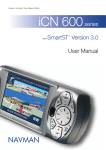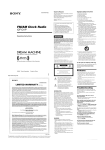Download IR detectors user's guide
Transcript
IR detectors user's guide 129/133 Poznanska St., 05-850 Ozarow Mazowiecki, Poland; tel. +48 22 733 54 20; fax +48 22 733 54 26; e-mail: [email protected] 1 Please note: the information contained in this document is subject to change without further notification. VIGO System reserves the right to alter the performance and any resulting specifications.VS- 11-06-29MB WARRANTY VIGO System S.A. hereby represents and warrants all Products manufactured by VIGO and sold hereunder to be free from defects in workmanship or material during a period of twelve (12) months from the date of delivery save for products for which a special warranty is given. If any Product proves however to be defective in workmanship or material within the period herein provided VIGO System undertakes to the exclusion of any other remedy to repair or at its own option replace the defective Product or part thereof free of charge and otherwise on the same conditions as for the original Product or part without extension to original warranty time. Defective parts replaced in accordance with this clause shall be placed at the disposal of VIGO. VIGO also warrants the quality of all repair and service works performed by its employees to products sold by it. In case the repair or service works should appear inadequate or faulty and should this cause malfunction or nonfunctioning of the product to which the service was performed VIGO shall at its free option either repair or have repaired or replace the product in question. The working hours used by employees of VIGO for such repair or replacement shall be free of charge to the client. This service warranty shall be valid for a period of six (6) months from the date the service measures were completed. This warranty is however subject to following conditions: 1. A substantiated written claim as to any alleged defects shall have been received by VIGO System within thir ty (30) days after the defect or fault became known or occurred, and 2. The allegedly defective Product or part shall, should VIGO so require, be sent to the works of VIGO or to such other place as VIGO may indicate in writing, freight and insurance prepaid, properly packed and labeled. This warranty does not however apply when the defect has been caused through 1. normal wear and tear or accident; 2. misuse or other unsuitable or unauthorized use of the Product or negligence or error in storing, maintaining or in handling the Product or any equipment thereof; 3. wrong installation, assembly or failure to service the Product or otherwise follow VIGO's service instructions including any repairs or installation or assembly or service made by unauthorized personnel not approved by VIGO or replacements with parts not manufactured or supplied by VIGO; 4. modifications or changes of the Product as well as any adding to it without VIGO's prior authorization; 5. burned active element by irradiation above damage thresholds 6. electrostatic discharges 7. improper detector bias 8. improper TE cooler bias (TE cooler damage or active element overheating). 9. other factors dependent on the Customer or a third party. Notwithstanding the aforesaid VIGO System liability under this clause shall not apply to any defects arising out of materials, designs or instructions provided by the Customer. This warranty is expressly in lieu of and excludes all other conditions, warranties and liabilities, expressed or implied, whether under law, statute or otherwise, including without limitation any implied warranties of merchantability or fitness for a particular purpose and all other obligations and liabilities of VIGO or its representatives with respect to any defect or deficiency applicable to or resulting directly or indirectly from the Products supplied hereunder, which obligations and liabilities are hereby expressly canceled and waived. VIGO's liability shall under no circumstances exceed the invoice price of any Product for which a warranty claim is made, nor shall VIGO in any circumstances be liable for lost profits or other consequential loss whether direct or indirect or for special damage. RMA Request Instructions: • No Product may be returned without first contacting VIGO for a Return Material Authorization ('RMA') number. • Please obtain a RMA number at [email protected] before returning any item. When requesting a RMA number, please state your order number, the product you wish to return and the reason for return. We will only accept returns which have an RMA number. Authorized returns are to be shipped according to received instruction from VIGO in appropriate shipping box. An unauthorized return, i.e. one for which an RMA number has not been issued and authorized returns however, shipped with incorrect customs documents - will not be accepted. • Please print the RMA number clearly on the return label to avoid any delay in processing. Please send package to: VIGO System S.A. 129/133 Poznanska St., PL 05-850 Ozarow Mazowiecki Poland 129/133 Poznanska St., 05-850 Ozarow Mazowiecki, Poland; tel. +48 22 733 54 20; fax +48 22 733 54 26; e-mail: [email protected] 2 Please note: the information contained in this document is subject to change without further notification. VIGO System reserves the right to alter the performance and any resulting specifications.VS- 11-06-29MB Introduction This guide is written to help users select and operate the first stage signal processing electronics (or preamp) of infrared detectors manufactured by VIGO. Please read this before operating the detector! Photoconductive Devices (PC) Photoconductive Devices (PC) are detectors based on the photoconductive effect. Infrared radiation generates charge carriers in the semiconductor active region decreasing its resistance. The resistance change is sensed as a voltage change by applying a constant current bias. The optimum bias current is specified in the Final Test Report and depends on the detector size, operating temperature and spectral characteristics. Photoelectromagnetic Devices (PEM) PEM detectors are photovoltaic devices based on the photoelectromagnetic effect. It relies on a spatial separation of optically generated electrons and holes in a magnetic field applied to the semiconductor by a permanent magnet built in to the detector housing. PEM detectors do not require electrical bias and show no flicker (1/f) noise. The devices are typically used as fast uncooled detectors of long wavelength radiation. Photovoltaic Devices (PV or PVM) Photovoltaic devices (photodiodes) are semiconductor structures with one (PV) or multiple (PVM) homo- or heterojunctions. Absorbed photons produce electron-hole pairs, resulting in external photocurrent. Reverse bias voltage may be applied to increase differential resistance, reduce the shot noise, improve high frequency performance and dynamic range. Reverse bias may increase responsivity in some devices. Unfortunately, at the expense of flicker (1/f) noise in most cases. PV detectors are more vulnerable to electrostatic discharges than photoconductors. Circuitry for Photoconductive Detectors A typical circuit for PC MCT detectors is shown in fig. 1a. The detectors are usually low impedance devices and require low input voltage noise preamplifiers. A constant bias current is used in the detector requiring a low noise DC voltage supply or battery with current-limiting resistor R L. Typically, AC coupling is used to prevent saturation of the preamplifier by detector bias. Rf hν + Vb a b Fig. 1: Preamplifier circutry for PC (a) and PV (b) detectors Circuitry for Photovoltaic Detectors Transimpedance preamps that provide constant voltage reverse bias are required for the best linearity and frequency response extend high frequency response beyond the unbiased values published in individual VIGO detector data sheets. Consult us for options. This can be achieved using transimpedance preamplifiers as shown in the Fig. 1b. This preamplifier provides also biasing of the detector with DC reverse voltage. In this way, the conditions for a maximum signal-to-noise ratio in a wide waveband are created. Electrical Interface TO-8 header TOhe- 39 ader Signal 1 and 2 Rever(optio1(-) 2(+) GND Signal 1 and 3 Reverse bias (optional) 1(-) and 3 (+) Thermistor 7 and 9 TE cooler supply 2(+) and 8 (-) GND 11 Not used 4, 5, 6, 10, 12 se bias nal) and 3 Fig. 2: Header pin layout, bottom view, dimensions in mm Signal (+) and (-) signs are to indicate direction of reverse bias in PV devices. For PC detectors bias polarity changes signal sign but is not important for performance and frequency response. For BNC or SMA connector based PV packages, the anode is connected to the inner pin and photocurrent flows from the outer shielding to the inner pin. Terms used in Detector Final Test Report Active Area The physical area of a photosensitive element, the active region that converts incoming optical radiation into electric output signal Optical Active Area The apparent active area of optically immersed detectors, which may differ from the physical active area due to immersion lens properties. Ambient Temperature, K Ambient temperature during test measurements. Thermistor Type, (TE cooled detectors only) Thermistor types and characteristics are available on VIGO System website. Typically, TB04-222 is used. Cooler Current and Voltage (TE cooled detectors only) Optimum current and voltage of Peltier element. Detector Temperature, K (TE cooled detectors only) Temperature measured by thermistor during test. Detector Resistance Dynamic resistance measured under specified bias condition. Reverse Bias Voltage/Bias Current Optimum reverse bias voltage for photovoltaic detectors and optimum bias current for photoconductors. The maximum allowable bias current is stated on the Detector Test Report supplied for each photoconductive detector. For photovoltaic devices, optimum reverse bias can be provided by VIGO upon request. Current/Voltage Responsivity @ λopt Current responsivity is typically used for photovoltaic detectors while voltage responsivity for photoconductors and photoelectromagnetic detectors. Stated values are given for the optimum wavelength or as otherwise agreed. Current/Voltage Noise Density, A/Hz1/2 or V/Hz1/2 Normalized per Hz1/2 noise current or noise voltage. Detectivity @ λopt, cmHz½/W The signal-to-noise ratio (SNR) at a detector output normalized to 1 W radiant power, a 1 cm2 detector optical area and a 1 Hz bandwidth. The higher the D* value, the better the detector. (Stated value is given for an optimum wavelength) Precautions for Use Operating temperature A detector should be operated at its optimal temperature given in the test report. Maximum voltage Do not operate the photovoltaic detector at higher bias voltages than suggested in the test report. Be careful using ohmmeters for photovoltaic detectors! Standard ohmmeters may overbias and damage the detector. This is especially true for small or SWIR photovoltaic detectors. Bias of 10 mV can be used for resistance measurements of any type of detector. Ask for conditions of I-V plot measurements! Usage Devices can operate in the 10-80% humidity, in the -20ºC to +30ºC ambient temperature range. Operation at >30ºC ambient may reduce performance for standard Peltier controllers. Ask for systems that can operate at 30-80ºC ambient. Storage The following conditions should be fulfilled for safe and reliable operation of detector: • store in dark place, 10% to 90% humidity and -20ºC to +50ºC temperatures • avoid exposing to the direct sunlight and strong UV/VIS light as this may result in degradation of a detector performance • avoid electrostatic discharges at leads therefore, the devices should be stored having leads shorted. Handling Some IR window materials such as BaF2 are soft. Particular attention should be paid to not scratch a surface of the window. A damaged window may entirely degrade the detector performance. Excessive mechanical stress applied to the package itself or to a device containing the package may result in permanent damage. Peltier element inside thermoelectrically cooled detectors is susceptible to mechanical shocks. Great care should be taken when handling cooled detectors. Beam Power Limitations Damage thresholds, specified as integrated power of incoming radiation: • For devices without immersion lens irradiated with continuous wave (CW) or single pulse longer then 1 µs irradiance on the active area must not exceed 100 W/cm2.The irradiance of a pulse shorter than 1 µs must not exceed 1 MW/cm2 • For optically immersed devices irradiated with CW or single pulse longer then 1 µs irradiance on the apparent optical active area must not exceed 2.5 W/cm2.The irradiance of the pulse shorter than 1 µs must not exceed 10 kW/cm2 • For repeated irradiation with pulses shorter than 1 µs, the equivalent CW irradiation, average power over the pulse - to - pulse period should be less than the CW damage threshold according to equation: equivalent CW radiation power = [(pulse peak power)/(focus area)]*[(pulse duration)*(repetition rate)]. • Saturation thresholds vary by detector type and can be provided upon request. Shaping Leads Avoid bending the leads at a distance less than 2 mm from a base of the package to prevent glass seal damage. When shaping the leads, maximum two right angle bends and three twists at the distance minimum 6 mm from the base of the package. Keep the leads of the detecting element shorted when shaping! Soldering Leads IR detectors can be easily damaged by excessive heat. Special care should be taken when soldering the leads. Usage of heat sinks is highly recommended. Tweezers can be used for this purpose; when soldering, clamp a lead at a place between the soldering iron and the base of the package. To avoid destructive influence of ESD and other accidental voltages (e.g. from a non-grounded soldering iron) rules for handling LSI integrated circuits should be applied to IR detectors too. Leads should be soldered at 370°C or below within 5 seconds. Cleaning Window Keep the window clean. Use a soft cotton cloth damped with isopropyl alcohol and wipe off the surface gently if necessary. Mechanical Shocks The Peltier elements may be damaged by excessive mechanical shock or vibration. Care is recommended during manipulations and normal use. Drop impacts against a hard surface are particularly dangerous. Temperature Sensor The built-in thermistor serves as a sensor of the active element temperature. The maximal power dissipated by the thermistor should not exceed 0.2 mW and for accurate temperature measurement, the power should be <0.03 mW. Heat Sinking Suitable heat sinking is necessary to dissipate heat generated by the Peltier cooler or excessive optical irradiation. Since heat is almost 100% dissipated at the base of the detector housing, it must be firmly attached to the heat sink (Figs. 3 a and b). Heat sinking via the mounting screw or via the detector housing cylindrical walls is not sufficient (Figs. 3 c and d). A thin layer of heat conductive epoxy or silicone grease should be applied to improve thermal contact between detector housing and heat sink. A heat sink thermal resistivity of ~2 K/W is typically required for the most two-stage and three-stage Peltier coolers. Four stage cooler require ~1 K/W. a YES b YES c NO d NO Fig. 3: Heat dissipation from TE cooled detector Troubleshooting First read the previous parts of this manual, especially Precautions for Use. If a problem persists, check through the information given below. General Test Procedure Check: • whether components of your measurement system are connected correctly • whether connections are snug-tight • whether supply voltages or currents of the components are consistent with the specification • whether an appropriate detector operating temperature is achieved (proper thermistor resistance or indicators on a cooler controller) • attenuation/gain factors at your measurement set-up • load at the preamplifier output For high frequency, > 20 MHz, signals impedances of the output and load must be matched. • whether bandwidths of the components are reasonably well-matched to each other, • whether the detector is not saturated or damaged by too strong irradiation Refer to Beam Power Limitations section of this manual. If a problem still exists, try to identify and solve it by actions mentioned below. • Cycle the power of the components off and on again. • After shielding/switching off the radiation source, do you see any signal decrease? If yes, most probably you see a signal from the optical radiation you hope to see. No or too weak response to optical radiation Check through General Test Procedure. If you do not have any other detector to test your radiation source, move a hot object (your hand or soldering iron) rapidly in front of the detector, across its whole field of view. (The higher temperature of the object or shorter its distance to the detector, the higher optical signal at the detector output.) • Test your detector with another available radiation source. A warm or hot object moved in front of the detector can be used for DC or low frequency AC coupled devices. • Align or improve your optical setup for the maximized signal or signal-to-noise ratio. • Estimate the detector response, taking into account an irradiation at the detector active area and the responsivity of the detector (or of the detection module), and check it against measured values. • Evaluate noise in the system. Calculate a noise introduced by the detector or detection module basing on their noise density from their data sheets. Check it against measured response of the blinded detector. Check if the radiation will be strong enough to obtain good signal-to-noise ratio. (A signal is easy to pick out of a noise when its peak to peak value is several times greater than of the noise.) If it is lower than expected, consider increasing the radiation power entering the detector active area. Check also if the radiation is not too strong causing detector saturation or damage. If you cannot obtain signal sufficiently higher than noise, contact your technical support. Excess noise Check through General Test Procedure. Excess noise may be caused by poor connections, ground connections and ground loops, high background photon flux or EMI (e.g. inductive motors driving radiation chopper). You may also decrease the noise by reducing your system bandwidth. If you are unable to identify external excess noise source, contact your technical support. Unstable signal Check through General Test Procedure. • the cables • the radiation sources • the DC or low frequency signal may vary due to fluctuations of thermal background radiation • whether temperature set-point was achieved (TE-cooled devices). If the device is still unstable, contact your technical support. Slow signal rise/fall time Check through General Test Procedure. Check: • the shape of the pulse with another detector if possible • the operating conditions (detector temperature, bias, optical setup) • if impedances of the detector, cables, preamplifier and your read-out instrument are matched • if the frequency response of your preamplifier was measured before integration with the detector. Operational temperature not reached Refer to Temperature Sensor and Heat Sinking sections of this manual. Check: • thermistor resistance or indicators on a cooler controller • check ambient temperature, whether this is not higher than maximal allowing for a given detector operating temperature • supply voltages and currents of the Peltier element supply • cooler controller circuitry and set-point • connections • check detector sealing; is condensation or ice deposition seen on detector element or eleswhere? If the operational temperature is still higher than expected or the hermetic detector package is unsealed, contact your technical support. Changed Detector Resistance Device resistance might change with time by a few percent. Larger variations are usually caused by degradation due to high optical irradiance or some other cause of excessive temperature on the active element (i.e. during soldering or improper TE cooler operation or incorrect bias). Check connections for short- or open-circuits. Let your technical support know about possible sources of degradation.




















